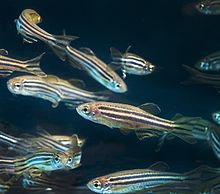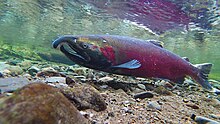Inbreeding in fish is the mating of closely related individuals, leading to an increase in homozygosity. Repeated inbreeding generally leads to morphological abnormalities and a reduction in fitness in the offspring. In the wild, fish have a number of ways to avoid inbreeding, both before and after copulation.
Exposure

Exposure of zebrafish to a chemical environmental agent, analogous to that caused by anthropogenic pollution, amplified the effects of inbreeding on key reproductive traits. Embryo viability was significantly reduced in inbred exposed fish and there was a tendency for inbred males to sire fewer offspring.
Effects
The effect of inbreeding on reproductive behavior was studied in the poeciliid fish Heterandria formosa. One generation of full-sib mating was found to decrease reproductive performance and likely reproductive success of male progeny. Other traits that displayed inbreeding depression were offspring viability and maturation time of both males and females.
Behaviors

The behaviors of juvenile Coho salmon with either low or medium inbreeding were compared in paired contests. Fish with low inbreeding showed almost twice the aggressive pursuit in defending territory than fish with medium inbreeding, and furthermore had a higher specific growth rate. A significant effect of inbreeding depression on juvenile survival was also found, but only in high-density competitive environments, suggesting that intra-specific competition can magnify the deleterious effects of inbreeding.
Inbreeding avoidance mechanisms
Inbreeding ordinarily has negative fitness consequences (inbreeding depression), and as a result species have evolved mechanisms to avoid inbreeding. Numerous inbreeding avoidance mechanisms operating before mating have been described. However, inbreeding avoidance mechanisms that operate after copulation are less well known. In guppies, a post-copulatory mechanism of inbreeding avoidance occurs based on competition between sperm of rival males for achieving fertilization. In competitions between sperm from an unrelated male and from a full sibling male, a significant bias in paternity towards the unrelated male was observed. It is a theory that females avoid inbreeding more than males due to the fact that when they mate with a sibling, they obtain 50% less sperm in their ovarian cavities in comparison to mating with a nonsibling.
Inbreeding depression

Inbreeding depression is considered to be due largely to the expression of homozygous deleterious recessive mutations. This is the consequence of mating between related parents, causing a decrease in fitness in the offspring. Outcrossing between unrelated individuals results in the beneficial masking of deleterious recessive mutations in progeny.
The mangrove rivulus Kryptolebias marmoratus produces eggs and sperm by meiosis and routinely reproduces by self-fertilization. Each individual hermaphrodite normally fertilizes itself when an egg and sperm that it has produced by an internal organ unite inside the fish's body. In nature, this mode of reproduction can yield highly homozygous lines composed of individuals so genetically uniform as to be, in effect, identical to one another. The capacity for selfing in these fishes has apparently persisted for at least several hundred thousand years.
Fertilization assurance
Although inbreeding, especially in the extreme form of self-fertilization, is ordinarily regarded as detrimental because it leads to expression of deleterious recessive alleles, self-fertilization does provide the benefit of “fertilization assurance” (reproductive assurance) at each generation.
References
- Bickley LK, Brown AR, Hosken DJ, Hamilton PB, Le Page G, Paull GC, Owen SF, Tyler CR (2013). "Interactive effects of inbreeding and endocrine disruption on reproduction in a model laboratory fish". Evolutionary Applications. 6 (2): 279–89. Bibcode:2013EvApp...6..279B. doi:10.1111/j.1752-4571.2012.00288.x. PMC 3689353. PMID 23798977.
- Ala-Honkola O, Uddström A, Pauli BD, Lindström K (2009). "Strong inbreeding depression in male mating behaviour in a poeciliid fish". J. Evol. Biol. 22 (7): 1396–406. doi:10.1111/j.1420-9101.2009.01765.x. PMID 19486236.
- Gallardo JA, Neira R (2005). "Environmental dependence of inbreeding depression in cultured Coho salmon (Oncorhynchus kisutch): aggressiveness, dominance and intraspecific competition". Heredity (Edinb). 95 (6): 449–56. doi:10.1038/sj.hdy.6800741. PMID 16189545.
- ^ Fitzpatrick JL, Evans JP (2014). "Postcopulatory inbreeding avoidance in guppies". J. Evol. Biol. 27 (12): 2585–94. doi:10.1111/jeb.12545. PMID 25387854.
- Ala-Honkola, Outi (2010). "Inbreeding avoidance in a poeciliid fish (Heterandria formosa)". Behavioral Ecology and Sociobiology. 64 (9): 1403–1414. doi:10.1007/s00265-010-0955-7.
- Charlesworth D, Willis JH (2009). "The genetics of inbreeding depression". Nat. Rev. Genet. 10 (11): 783–96. doi:10.1038/nrg2664. PMID 19834483. S2CID 771357.
- Bernstein H, Hopf FA, Michod RE (1987). "The Molecular Basis of the Evolution of Sex". Molecular Genetics of Development. Advances in Genetics. Vol. 24. pp. 323–70. doi:10.1016/s0065-2660(08)60012-7. ISBN 9780120176243. PMID 3324702.
- Sakakura Y, Soyano K, Noakes DLG, Hagiwara A. (2006). Gonadal morphology in the self-fertilizing mangrove killifish, Kryptolebias marmoratus. Ichthyological Research, Vol. 53, pp. 427-430.
- ^ Avise JC, Tatarenkov A (2012). "Allard's argument versus Baker's contention for the adaptive significance of selfing in a hermaphroditic fish". Proc. Natl. Acad. Sci. U.S.A. 109 (46): 18862–7. Bibcode:2012PNAS..10918862A. doi:10.1073/pnas.1217202109. PMC 3503157. PMID 23112206.
- Earley RL, Hanninen AF, Fuller A, Garcia MJ, Lee EA (2012). "Phenotypic plasticity and integration in the mangrove rivulus (Kryptolebias marmoratus): a prospectus". Integr. Comp. Biol. 52 (6): 814–27. doi:10.1093/icb/ics118. PMC 3501102. PMID 22990587.
- Tatarenkov A, Lima SM, Taylor DS, Avise JC (2009). "Long-term retention of self-fertilization in a fish clade". Proc. Natl. Acad. Sci. U.S.A. 106 (34): 14456–9. Bibcode:2009PNAS..10614456T. doi:10.1073/pnas.0907852106. PMC 2732792. PMID 19706532.